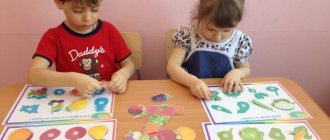Definition of didactics
The word “didactics” is translated from ancient Greek as “educational”. So, when children are taught in an informal play atmosphere, when the child “learns while playing,” experiencing pleasure from the process, this is both a lesson and a game, a didactic game.
A child’s imaginative thinking is directly related to the fact that a little person learns about the world in a playful way.
If you and your child spent the weekend at the zoo, and he was impressed by the orangutan Buba, then get ready for the next few days that all family members will participate in a game called “Buba in the Zoo”.
Imaginative thinking helps a child feel the beauty of the world around him, believe in fairy tales, and develops imagination and creative abilities.
A game for a preschooler is a way of life. And if the game is given an educational focus, then one hundred percent mastery of the material is guaranteed. This is why the didactic game for speech development is so actively used when working with children.
Role
It is known that children love to play. Games occupy a large part of their active activities. In games, the baby learns about the world and himself, acquiring new communication skills and developing speech. An important role is played by role-playing games.
Didactic games
The essence of role-playing games is that the child tries on different social roles. While completing tasks, children interact and communicate with each other in the form of dialogue. Role-playing games help children learn to independently improve communication skills from the age of 2-3, train memory, attention, imagination and have a direct impact on the development of dialogic speech.
Development of fine motor skills of the hands as a means of speech development in children
Fine motor skills of the hands affect the development of correct speech. It has been proven that the speech apparatus develops under the influence of impulses entering the brain from the nerve endings of the fingertips. The development of motor skills is considered one of the main means for the formation of competent and correct speech. A whole set of exercises has been developed to train fine motor skills of the hands. One of them is finger gymnastics.
The influence of finger exercises on speech development
Finger gymnastics exercises have a direct effect on the development of speech in children, because impulses coming from the nerve endings at the fingertips stimulate the areas of the brain responsible for speech.
Important! Parents need to know that finger gymnastics with a baby can be done starting from 3-4 months, since at 2-3 years it will be too late.
Exercises help to develop the right and left hemispheres of the brain evenly. The right is responsible for figurative thinking, the left is for reproducing words denoting a specific object.
An example of finger gymnastics
Note! In order for speech to keep up with the formation of thoughts, it is necessary to use finger exercises.
Card index of didactic games according to the Federal State Educational Standard
Examples of interesting board games:
- "One is many." Age: 4-5 years. The goal is to teach children the formation of plural numbers and the use of words in the genitive case, the selection of definitions for words and teaching meanings of action. Material: cards with pictures of objects. The essence: they show a card with a picture and ask questions about the object depicted on it, and the kids answer.
- “Where is whose house?” Age: 5-6 years. Goal: development of speech, memory, imaginative and logical thinking. Material: 2 types of pictures: depicting animals and animal dwellings. The bottom line: the cards are distributed equally among the children, and then they look for the correct pair for their pictures.
The use of mnemonics in the development of speech in preschool children
Purpose of the game
Didactic games develop in a child:
- Cognitive skills. The child observes, learns a lot of new things, expands existing knowledge about the world around him, living and inanimate nature.
- Mental capacity. A person learns to think, express his thoughts, construct sentences, reason. And also - remember, compare, evaluate.
- Speech. The vocabulary increases significantly, pronunciation improves, the ability to participate in dialogues and pronounce monologues is formed.
- Moral qualities. The child learns to help, sympathize, restrain himself, and respect others.
- Social adaptation. Skills are acquired such as the ability to conflict, participate in competition, interact with peers, adults, give in to others, and not be offended.
Therefore, if your baby has been asking you to play with him for half an hour, and you have absolutely no time for this, give him a jar of semolina with beans hidden in it, and ask him to prepare dinner for the zoo pets. While you are cooking borscht for dad)).
Types and examples of didactic games for preschoolers
Didactic games differ in content, actions, rules and come in three types:
- games with objects;
- printed board games;
- verbal didactic games.
Their degree of difficulty can be adjusted depending on the age of the participants. The same game can have several variants. For example, kids arrange cards by color; Older children name numbers; and someone can already put the word together.
Games with objects
1. Magic bag
You need to pull out objects of different shapes by touch from the bag: a ball, a cube, a pyramid. Or objects with different textures: pine cone, acorn, chestnut.
2. Rainbow
The child is invited to arrange cubes, mosaics, and pyramids by color.
During didactic games with objects, the child learns to think, analyze, compare objects with each other, he becomes more attentive, his horizons expand, and his fine motor skills improve.
Board-printed games
There is a huge scope for choosing what will be most interesting to your baby at a given time. It can be:
- Pictures for recognition in the form of images, shadows, contours.
- Puzzles.
- Lotto.
- Pictures: find the differences.
- Pictures: pick a pair.
- Labyrinths.
- Designers.
Such didactic games for preschoolers on speech development are interesting and educational. They successfully develop speech skills, logic and imagination, and develop perseverance and patience.
Word games
This type of cognitive communication is very relevant when there are no special objects at hand, so you can use the most familiar things. Here are some examples of such didactic games for the development of speech in preschoolers.
1. Doll
Description of the appearance: color of hair, eyes, clothing items of the fashionable doll.
2. Who is missing?
Place several soft toys nearby. Ask them to close their eyes and remove one. Who can guess: who is missing? We need to name it, tell it what it looks like, figure out where it ran away to.
3. Cube
They roll a dice with pictures on each side. You need to name what is depicted on the top edge and imitate the sound of the object. For example, a steam locomotive. How does the locomotive sound?
4. Catch the ball - name the word that has the opposite meaning. Hot-cold, big-small, close-far.
Verbal games for preschoolers develop speech, reaction speed, correct pronunciation of sounds, expand vocabulary, teach how to construct sentences correctly, and express their thoughts coherently.
Exercises and tasks
The main exercises and tasks that need to be done daily at home for the active development of coherent speech are:
Articulation gymnastics
- Eat some jam. You need to imagine that after eating the pie there is jam left on your lips that needs to be licked. Using your tongue, smoothly lick the jam from the lower and upper lips.
- Spade tongue. It is necessary to imagine that the tongue is a shovel, which should lie on the stand (lower lip) for as long as possible. We extend the tongue, placing it on the lower lip, and hold it in this position for 10-15 seconds.
- The tongue is a needle. You need to imagine that the tongue is a thin needle that needs to be held in place. We stretch out our tongue, trying to make it narrow, and try to hold it for 10-15 seconds.
- I'm a horse. The child needs to imagine himself as a horse that clatters its hoofs and clicks its tongue. We stomp our right and left feet in turn, clicking our tongue as we do so.
These exercises are best done for no more than 5-7 minutes and repeated 2 times a day.
It’s more fun to do articulation gymnastics with children by looking at pictures and reading rhymes.
Finger games
- Kitty. Both palms are clenched into fists and lie on a flat surface. It is necessary to simultaneously straighten the fingers on both handles, pressing them tightly to the table. The exercise must be repeated 4-5 times. After several lessons, the task can be complicated: first, the fingers on one hand are straightened, then they are compressed, and on the second they are straightened.
- Let's treat the cat with milk. Palms as if scooping out milk.
- Bunny. The fingers imitate the ears of a bunny, the fingers run along the table, clenched into a fist, fist in fist.
- Dog. The index finger shows the tail of the dog, the fingers are clenched into a fist, the thumb is raised up, the fingers run away.
Using finger games with parallel learning of rhymes can show quite good results, since there is a strong relationship between the human hand and the speech center of the brain. The baby easily and more emotionally perceives information and reproduces it in the future without problems.
Logorhythmics
Logorhythmics is the simultaneous reading of poetry, accompanied by a certain set of movements against the background of thematic music. Initially, the adult shows everything by example, after which the child is asked to repeat what he just saw.
The optimal time to complete this task is the second half of the day, the regularity of classes is every 1-2 days.
A special place in speech development classes is given to cartoons, which children love so much. There are specially designed cartoons aimed at reinforcing the letters of the alphabet, learning colors, learning to count and speech development.
The choice of cartoons remains up to the parents, but a prerequisite is its versatility (for both boys and girls), the presence of positive characters, and high quality video and sound.
Do-it-yourself didactic games for speech development
Didactic games on speech development can be organized at home, starting from a very young age of your baby. Fine motor skills of fingers in such games will best affect the ability to speak, clearly pronounce words and sounds, and construct sentences.
Didactic games with handmade materials will help preschoolers develop their speech.
Teddy bear and cones
It is very interesting, even for adults, to use tactile sensations in playing with ordinary multi-colored balloons, having previously filled them with various cereals, flour, starch, and pasta. Just don’t inflate them).
Using your imagination, you can act out a scene with a bear collecting cones and balls in a clearing.
After the baby is playing, you can disassemble the basket with “cones”: arrange them by color, crush them and guess the contents.
Puppet show
Really, theatrically, act out your favorite fairy tale. Being the presenter or character, the child will retell the story, or even enthusiastically, on the go, come up with a new plot. You will have no choice but to play along with a serious look, smiling internally and giving warmth to the young talent.
Fabric store
Collect as many scraps of fabrics that differ in texture as possible. The dressmaker daughter will come to the store to buy material for a dress for her doll Dasha. She will definitely touch everything you offer her and choose flowing silk for her ball gown. Don't forget to draw her attention to the buttons: there are so many of them, they are so different. So be prepared for the fact that she may need your advice.
If you don’t have anything at hand, you can quote a line from your favorite poem and ask your child to continue, or remember what it’s about, what it’s called.
The most important thing is that games are communication with a little person who, with our help, begins the journey called “life”. Let's make it unforgettable, joyful, filled with living warmth.
Norms of speech development at the age of 2-3 years
Speech development occurs between the ages of 0 and 3 years. Normally, this happens in several stages, and parents should understand them. In the period from 0 to 1 year, onomatopoeia and babbling become more active in the child’s speech. By the age of one year, the first words appear; there should be from 10 to 25 or more. The baby understands spoken speech, follows simple instructions, and knows the names of objects in the surrounding space. By the age of two, coherent speech is actively developing. Words form a sentence. In the third year of life, the baby begins to be interested in the world around him, and his vocabulary is actively expanding. Phrases become detailed and grammatically correct, and word creativity appears.
Lesson on speech development at a preschool educational institution









